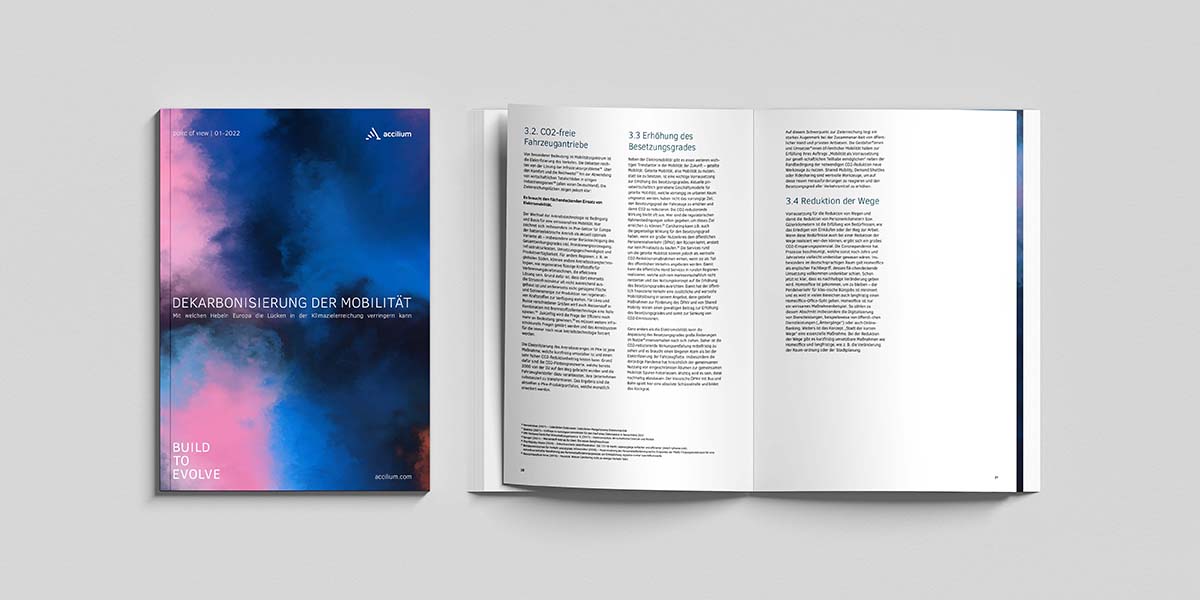Climate change is the central challenge facing our modern society. The internationally recognized IPCC describes the trend as “widespread, rapidly intensifying” and warns that carbon dioxide emissions must be reduced rapidly. Yet the transport sector is considered one of the main emitters of greenhouse gases worldwide. Which levers can be used to reduce the gaps in climate target achievement in the mobility sector can be read in the calculations and derivations of our latest study.
With the decision of the Paris Climate Agreement 2015, the World Climate Conference committed to a maximum global warming of 1.5 degrees compared to the pre-industrial era. Specifically, global CO2 emissions are to be reduced by 45% by 2030 compared to 2010 levels, and net zero emissions are to be achieved globally by 2050. At both European and national level, these concrete requirements have been supplemented by national long-term reduction strategies such as the “European Green Deal”.
Thus, the heads of state of the EU countries agreed on the binding EU target to reduce greenhouse gas emissions in the EU by at least 55% net by 2030 compared to 1990 levels. The recently signed coalition agreement of the “traffic light coalition” in Germany as well as the government program “Aus Verantwortung für Österreich” (Responsibility for Austria) also include the fight against climate change and compliance with the Paris climate targets as a core element.

Mobility as an emission driver
A strong focus in efforts to reduce greenhouse gas emissions is on the transport sector. While mobility is one of the fundamental pillars of modern society and a driver of global economic development, around 25% of greenhouse gas emissions worldwide are attributable to the transport sector, of which road transport accounts for around 18%. 1 In the EU, the share of CO2 emissions caused by road transport is even significantly higher at around 26%. 2 Even for the geographic focus on Germany and Austria, decarbonizing mobility remains an enormous challenge, as mobility is the area with the greatest need for action on the path to achieving the EU climate targets.
Target achievement gaps in the EU, Germany and Austria
The target set by policymakers is ambitious. The question of whether the target can be reconciled with previous measures and forecasts for the development of CO2 emissions was pursued in the study “Decarbonization of Mobility”. Based on various data sources, the challenge of CO2 reduction in transport was systematically analyzed for the EU as well as the EU member states, using the following data bases:
- Measured historical data on CO2 emissions from the transport sector.
- Valid forecasts on the further development of CO2 emissions
- Political target curves that are in line with climate targets
The application examples for the EU, Germany and Austria presented in the study clearly show that there are considerable target achievement gaps that cannot be closed without further, target-oriented measures.
The study shows which measures are available as effective levers for reducing greenhouse gas emissions in mobility. The following three levers were identified:
- CO2-free vehicle drives
- Increasing the occupancy rate
- Reduction of journeys
Furthermore, an impact assessment was carried out with regard to the three levers using Germany as an example:
- How much CO2 can be saved per year with which share of e-vehicles in the total passenger car population in Germany.
- How increasing the occupancy rate affects the annual reduction in CO2.
- How reducing the distance traveled affects annual CO2 emissions.
In the coming weeks, we will explore the topic with regard to a number of concrete measures in the mobility sector. How can new mobility services complement public transport? How can routes be saved through the digitization of public services? What role do regional freight distribution centers, MaaS and tourist mobility play?
[1] Statista (2021) – CO2 emissions. Share of transport
[2] Federal Office of Statistics (2021) – Straßenverkehr: EU-weite CO2-Kohlendioxid-Emissionen seit 1990 um 24 %

 ISO/IEC 27001:2013 certified
ISO/IEC 27001:2013 certified